The MiG-31 Foxhound at Fifty: An Analysis of the MiG-31 Interceptor’s Enduring Legacy and Future
Introduction
The Mikoyan MiG-31, known to NATO as the “Foxhound,” represents the zenith of a highly specialized design philosophy: the dedicated, high-speed, long-range homeland defense interceptor.
Born from the specific shortcomings of its famous predecessor, the MiG-25 “Foxbat,” the MiG-31 was not merely an upgrade but a doctrinal and technological revolution.
Its development in the 1970s, leading to a maiden flight in September 1975 and entry into service in 1981, was driven by the urgent need to protect the vast, sparsely covered regions of the Soviet Union against a new generation of low-flying NATO bombers and cruise missiles.
The introduction of the world’s first fighter-mounted phased-array radar, coupled with extreme speed, altitude, and range, created a unique area-denial capability that has allowed it to remain strategically relevant for nearly half a century.
As one of the fastest operational combat aircraft in the world, its role has evolved dramatically, from hunting Cold War reconnaissance aircraft to launching hypersonic missiles in 21st-century conflicts.
The Foxhound’s story is one of remarkable adaptation and enduring, if niche, dominance.
A New Threat, A New Guardian: The Genesis of the MiG-31
The strategic necessity for the MiG-31 is best understood by examining the operational and technological gaps left by its predecessor in the face of evolving NATO threats.
The MiG-31 was not just a better aircraft; it was the answer to a problem the MiG-25 was never designed to solve.
The Limitations of the “Foxbat”
The Mikoyan-Gurevich MiG-25 “Foxbat” was a fearsome symbol of Soviet air power, designed with a singular purpose: to intercept high-altitude, high-speed American strategic bombers like the B-58 Hustler and the anticipated, though ultimately cancelled, XB-70 Valkyrie.
Its blistering speed and operational ceiling, first observed by the West in the late 1960s, sent shockwaves through Western intelligence communities and directly spurred the development of the McDonnell Douglas F-15 Eagle.7 However, this extreme specialization was also its greatest weakness.
When Soviet pilot Viktor Belenko defected to Japan with his MiG-25P in 1976, Western analysts were finally able to examine the aircraft up close. They discovered that its impressive performance masked technological crudeness—it was built primarily of heavy nickel-steel alloy and relied on antiquated vacuum-tube electronics—and, more importantly, it suffered from critical operational deficiencies.
The Foxbat’s most significant flaw was its Smerch-A radar, which possessed no look-down/shoot-down capability. This meant the radar was effectively blind to targets flying below the interceptor, as it could not distinguish an aircraft from the background “clutter” of the ground.
This rendered it useless against the emerging NATO threat of low-level penetrating bombers and cruise missiles, which were designed specifically to fly “under the radar”.
Furthermore, the MiG-25’s airframe, optimized for the thin air of the stratosphere, performed poorly at low altitudes. It was cumbersome, had a high wing loading, and was structurally limited to a modest 4.5 Gs, making it an ineffective dogfighter against more agile Western aircraft.
Its Tumansky R-15 turbojet engines, while immensely powerful, were also incredibly fuel-thirsty, severely limiting the aircraft’s combat radius and patrol endurance. This relegated the MiG-25 to a “point defense” role, capable of a rapid dash to intercept a known target but lacking the legs for wide-area patrol.
Pushing the engines to their fabled Mach 3.2 limit was an emergency-only measure that would result in their destruction.
The PVO’s Dilemma: A Shift in Doctrine
These limitations created a critical dilemma for the Soviet Air Defence Forces, the Protivovozdushnaya Oborony (PVO), a separate branch of the military tasked with defending the homeland’s airspace.18 Soviet defensive doctrine was shaped by its geography: a vast, contiguous landmass with immense, sparsely populated territories, particularly in the Arctic, which was the most direct attack vector for US bombers.
This geography demanded “area defense” interceptors with immense range and endurance, a role filled inadequately by older aircraft like the Tupolev Tu-128 “Fiddler”.11
When NATO shifted its strategic bombing doctrine in the late 1960s and early 1970s away from high-altitude dashes to low-level penetration, the PVO’s premier interceptor, the MiG-25, was suddenly optimized to solve the previous war’s problem.
The emergence of agile fighters like the F-15 and low-flying threats like the B-1 bomber and air-launched cruise missiles (ALCMs) like the AGM-86B created a complex, multi-axis threat that the one-dimensional MiG-25 could not counter.
This doctrinal pivot by NATO necessitated a corresponding pivot by the PVO. A new type of interceptor was required, one that could:
- Operate with long range and endurance over the vast northern territories where ground-based radar coverage was minimal.
- Possess a powerful look-down/shoot-down radar to detect and engage low-flying cruise missiles and bombers against the challenging backdrop of the earth’s surface.
- Operate semi-autonomously, networked with other aircraft to form a “flying radar” barrier, reducing the reliance on the traditional Soviet method of rigid ground-controlled interception (GCI).
This new requirement led directly to the development of the Ye-155MP prototype, which began detailed design work in 1969. After its first flight on September 16, 1975, it would evolve into the production MiG-31, an aircraft designed not merely as a technical upgrade, but as the solution to a fundamentally new strategic challenge.
The MiG-31 was the Soviet answer to both the B-1 and the F-15, embodying a systemic shift from point defense to wide-area denial.
Anatomy of a High-Speed Hunter: Design and Technology
The MiG-31’s design represents a tightly integrated system of advanced technologies, where each component—airframe, propulsion, and avionics—was synergistically developed to fulfill its unique and demanding mission profile.
Airframe and Propulsion: Strength at Speed
While bearing a strong family resemblance to the MiG-25, the MiG-31’s airframe is a fundamentally new and more robust design.
Its material composition marked a significant evolution from the Foxbat’s heavy, 80% nickel-steel construction. The Foxhound’s airframe is a sophisticated blend of 49% arc-welded nickel steel, 33% light metal alloy, 16% titanium, and 2% composites.
This stronger, more advanced structure, combined with a reinforced three-spar wing and the addition of leading-edge root extensions (LERX), endowed the MiG-31 with capabilities its predecessor lacked. It could sustain supersonic flight at low altitude, reaching Mach 1.23 (1,500 km/h), and was stressed for a higher load factor of 5 Gs, a modest but important improvement.
Propulsion is provided by a pair of Soloviev D-30F6 afterburning turbofans, the first two-spool engines with an afterburner to be used on a Soviet fighter.
These were a revolutionary improvement over the MiG-25’s thirsty R-15 turbojets. The D-30F6 offered vastly better specific fuel consumption (SFC of 0.72 kg.kp⁻¹.h⁻¹ on maximum military power), which was a critical factor in achieving the long range and endurance required for the area-denial mission.
MiG-31. Image Credit: Creative Commons.
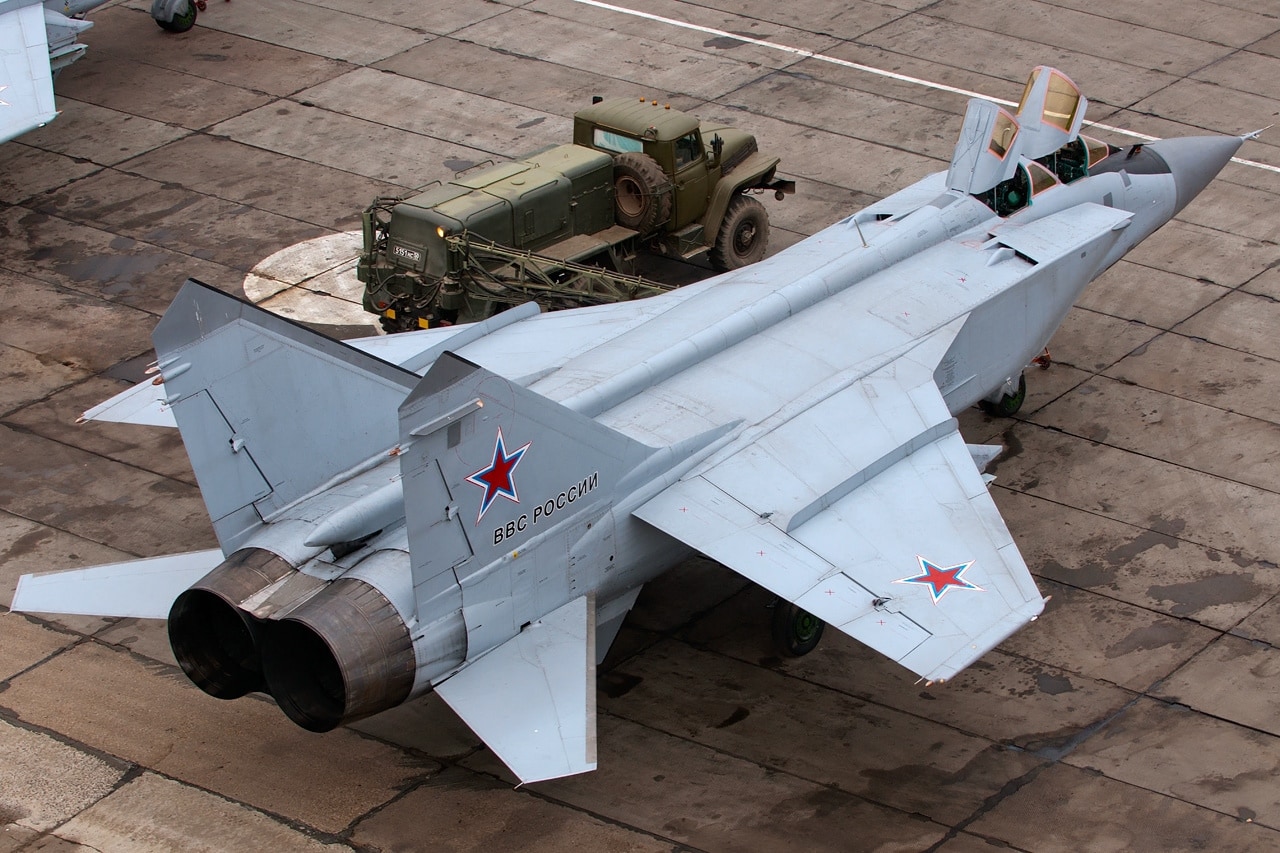
MiG-31: Image: Creative Commons.
Each engine produces 93.16 kN (20,900 lbf) of dry thrust and a massive 152 kN (34,000 lbf) with afterburner.
This power allows the 46-ton aircraft to reach a top speed that is redlined at Mach 2.83 (3,000 km/h) to preserve engine and airframe life, though it is capable of higher bursts.
A distinctive feature reflecting its intended operational environment is its landing gear: the main gear units feature two wheels arranged in a staggered tandem configuration, which improves weight distribution and allows for operations from the unprepared or ice-covered airfields common in Russia’s northern regions.
The Zaslon Revolution: The World’s First Fighter PESA
The heart of the MiG-31 weapon system is the RP-31 N007 Zaslon (NATO reporting name: “Flash Dance”), the world’s first Passive Electronically Scanned Array (PESA) radar to enter service on a fighter aircraft.
This was a revolutionary leap beyond the mechanically scanned antennas of its contemporaries. Developed by the Tikhomirov Scientific Research Institute of Instrument Design (NIIP), the Zaslon’s large, 1.1-meter fixed antenna could steer its radar beam electronically in just 1.2 milliseconds, a near-instantaneous process compared to the 12-14 seconds a traditional mechanical radar needed to complete a full scan.
This technological advantage translated into unprecedented capabilities. Its primary function was true look-down/shoot-down performance, enabling it to detect and track small, low-flying targets like cruise missiles against the challenging backdrop of ground clutter.
Early tests demonstrated its ability to detect a target with a radar cross-section (RCS) of 1 m² from an altitude of 6,000 meters.
The original Zaslon had a detection range of 200 km against a bomber-sized target (16-19 m² RCS) and could track up to 10 targets while simultaneously engaging four with its R-33 missiles—a capability matched in the West only by the US Navy’s F-14 Tomcat and its AWG-9/AIM-54 Phoenix combination.28
This powerful radar underpinned a doctrinal foresight that was decades ahead of its time. The MiG-31 was equipped with an APD-518 datalink that enabled a form of network-centric warfare long before the term was coined.
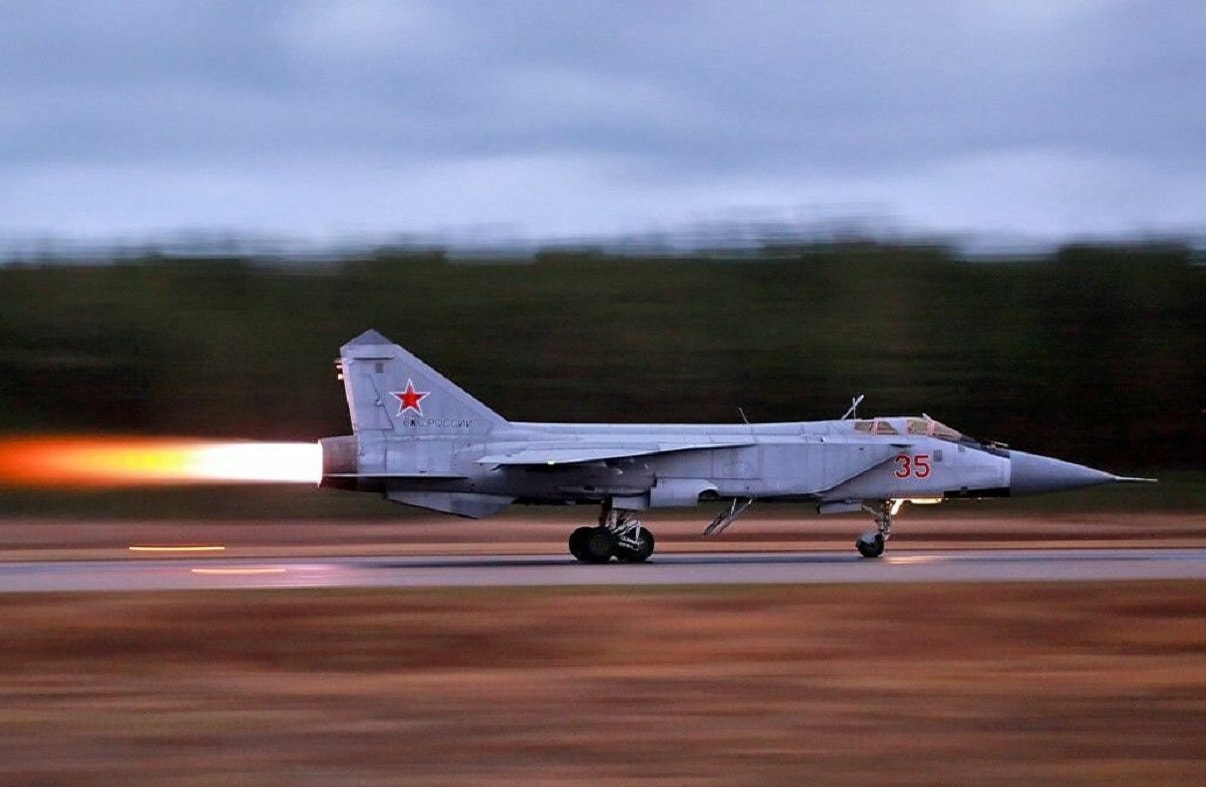
MiG-31. Image: Russian state media.
A flight of four MiG-31s could establish a coordinated patrol line 800-900 km wide, automatically sharing target data via the secure link.
In this formation, one MiG-31 could act as a “mini-AWACS,” illuminating targets and guiding the missiles of other fighters (including Su-27s or MiG-29s) whose own radars remained off, providing a massive tactical advantage and a degree of passive engagement.
This concept of distributed lethality, where the group acts as a single weapon system, is a central tenet of modern air combat that was a foundational principle of the MiG-31’s operational concept forty years ago.
The Two-Crew Cockpit
The immense complexity of managing the Zaslon radar and the associated datalinks during long-duration, semi-autonomous patrols necessitated a two-person crew, a major departure from the single-seat MiG-25P interceptor.
The pilot occupies the front cockpit, focusing on flying the aircraft, while a dedicated Weapon Systems Officer (WSO) sits in the rear cockpit, responsible for managing the powerful radar, datalinks, and weapons employment.
The WSO’s cockpit has very limited external visibility, with only small side windows, forcing reliance on the radar display and a retractable periscope for situational awareness.11 This design deliberately focuses the WSO’s attention on the electronic battle. The rear station features a basic set of flight controls for emergency use, and both crew members are equipped with Zvezda K-36DM “zero-zero” ejection seats, renowned for their safety and reliability.
The Long Lance: Armament and Evolving Mission Sets
The MiG-31’s weaponry has evolved in lockstep with its airframe and avionics, transforming the platform from a pure interceptor into a multi-role asset and even a strategic strike weapon.
The R-33 “Amos” – A Purpose-Built Weapon
The Vympel R-33 (NATO: AA-9 “Amos”) long-range air-to-air missile was not merely an armament option for the MiG-31; it was developed in parallel as part of a single, integrated weapon system with the aircraft and its Zaslon radar.
It is a very large and heavy missile, weighing 490 kg and measuring 4.15 meters in length, explicitly designed to destroy high-value, high-speed targets like the SR-71 Blackbird, B-1 Lancer, and B-52 Stratofortress from extreme range.
The R-33’s guidance system was a product of its time, employing a combination of inertial navigation for the initial flight phase, mid-course updates from the MiG-31’s datalink, and semi-active radar homing (SARH) for the terminal attack.
This SARH guidance required the Zaslon radar to continuously illuminate the target until the missile impacted, a potential vulnerability as it forced the MiG-31 to maintain its course. The Foxhound carries four R-33s in semi-recessed ejector pylons under its fuselage, a configuration reminiscent of the F-14’s carriage of AIM-54 Phoenix missiles.
The improved R-33S variant, introduced with the upgraded MiG-31B, featured a more advanced digital seeker and an extended range of 160 km, compared to the original’s 120 km.
Modern Munitions: The R-37M “Axehead”
The comprehensive modernization of the Foxhound fleet to the MiG-31BM/BSM standard introduced a far more lethal weapon: the Vympel R-37M (NATO: AA-13 “Axehead”). A direct descendant of the R-33 and the ambitious R-37 missile developed for the cancelled MiG-31M program, the R-37M dramatically enhances the Foxhound’s combat potential.

MiG-31. Image Credit: Creative Commons.
The missile boasts an astonishing engagement range, variously cited as being between 300 km and 400 km, far outstripping its Western counterparts.
Its most critical feature is an active radar homing (ARH) seeker. This “fire-and-forget” capability is a tactical game-changer. Unlike the R-33, the R-37M does not require the launch aircraft to maintain a radar lock for the entire duration of the engagement. The MiG-31 can launch the missile and immediately perform defensive maneuvers, significantly increasing its survivability.
This combination of extreme range, high speed, and ARH guidance, launched from the MiG-31’s high-altitude, high-speed perch, has proven to be a devastatingly effective system in the Russo-Ukrainian War.
The Kinzhal Carrier: From Interceptor to Strategic Striker
The most profound evolution in the MiG-31’s four-decade career is its modification into the MiG-31K, a dedicated launch platform for the Kh-47M2 Kinzhal (NATO: AS-24 “Killjoy”) air-launched ballistic missile (ALBM).
This transformation represents a complete inversion of the platform’s original purpose. Conceived as the ultimate defensive shield for the Soviet homeland, the MiG-31K has become a potent offensive strategic strike weapon.
The MiG-31 was selected as the Kinzhal’s carrier for its unique performance envelope. Its ability to climb to altitudes above 15 km and accelerate to speeds approaching Mach 3 provides the perfect high-energy launch state for the missile.
This launch profile acts as a “first stage” for the Kinzhal, imparting significant initial kinetic and potential energy, which extends its effective range to a claimed 2,000 km (a figure that includes the aircraft’s own combat radius) and helps it achieve a terminal velocity of up to Mach 10.
The conversion to a MiG-31K is substantial. The airframe is structurally reinforced with new attachment points to carry the massive 4,300 kg Kinzhal on a single centerline pylon.
The standard air-to-air fire-control system is removed or heavily modified; the MiG-31K is a dedicated strike aircraft and cannot perform its interceptor role while armed with the Kinzhal.
New avionics, digital computers, and datalink systems are installed, allowing the WSO to input target coordinates and manage the complex launch sequence, with some reports suggesting an ability to retarget the missile after launch.
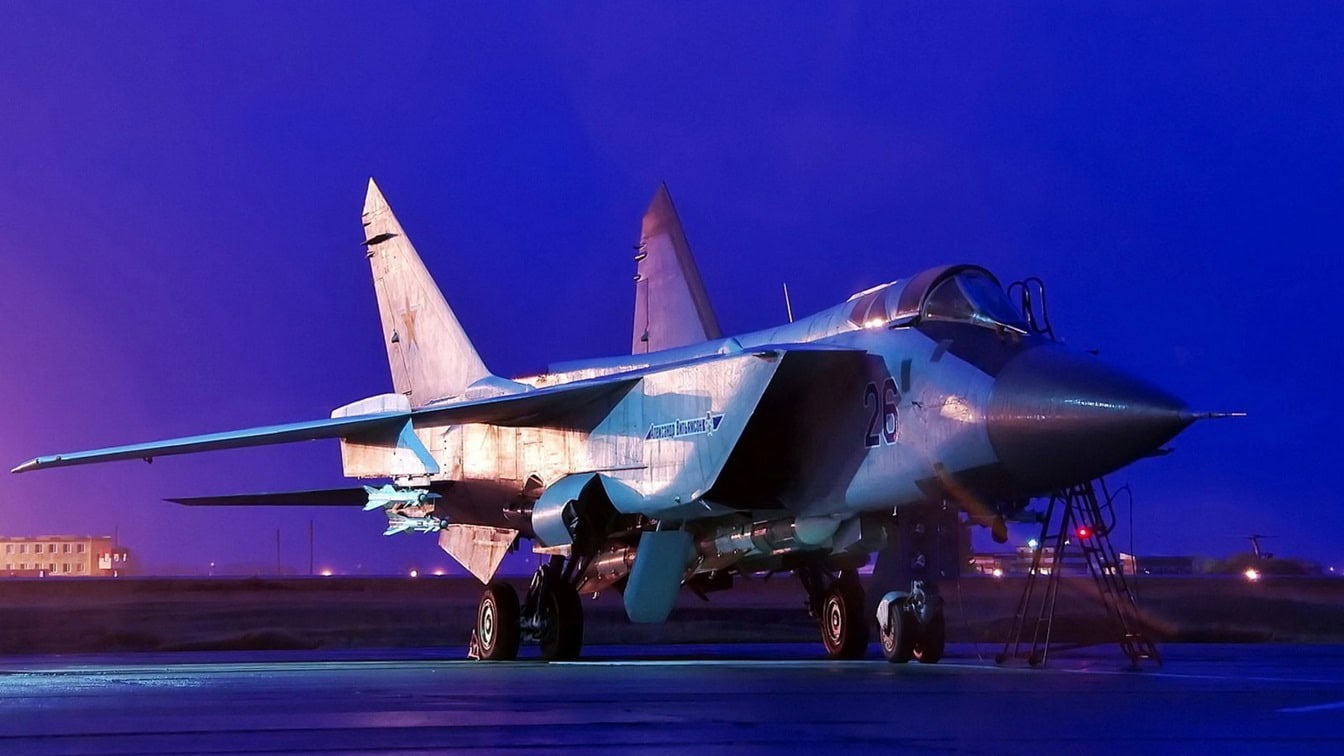
MiG-31 fighter. Image Credit: Creative Commons.
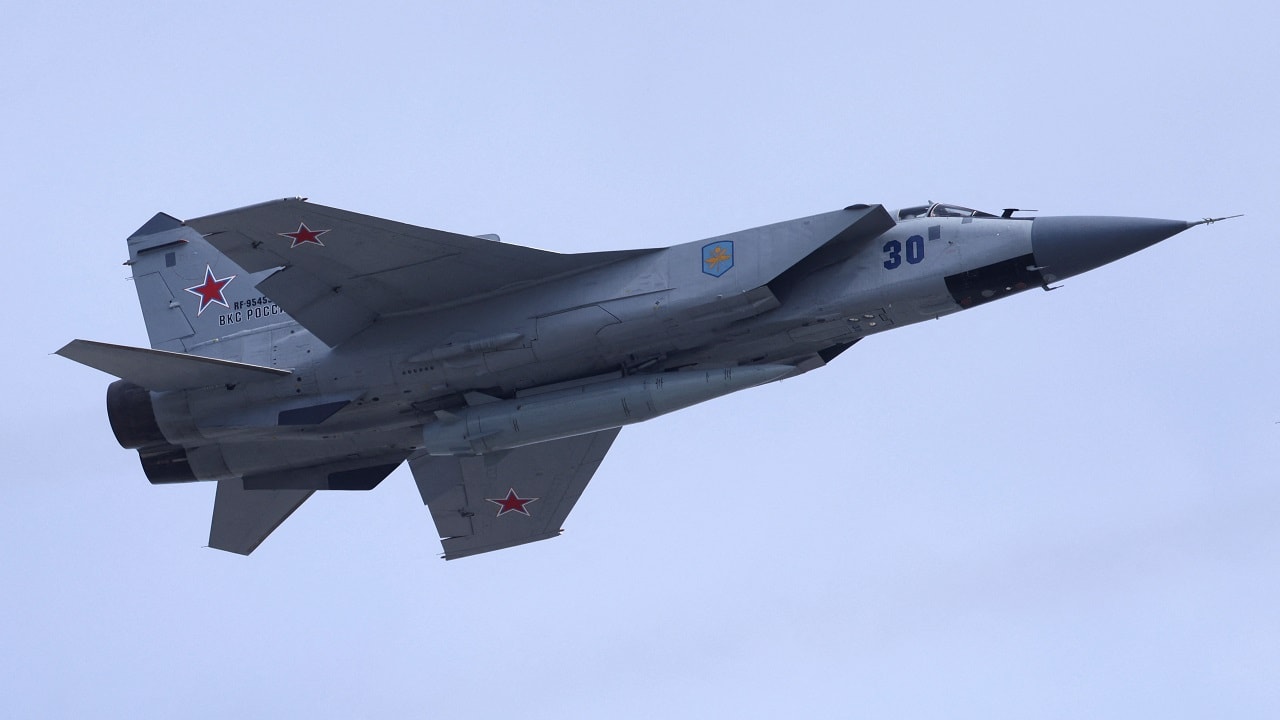
A Russian MiG-31 fighter jet equipped with a Kinzhal hypersonic missile flies over Red Square during a rehearsal for a flypast, part of a military parade marking the anniversary of the victory over Nazi Germany in World War Two, in central Moscow, Russia May 7, 2022. REUTERS/Maxim Shemetov
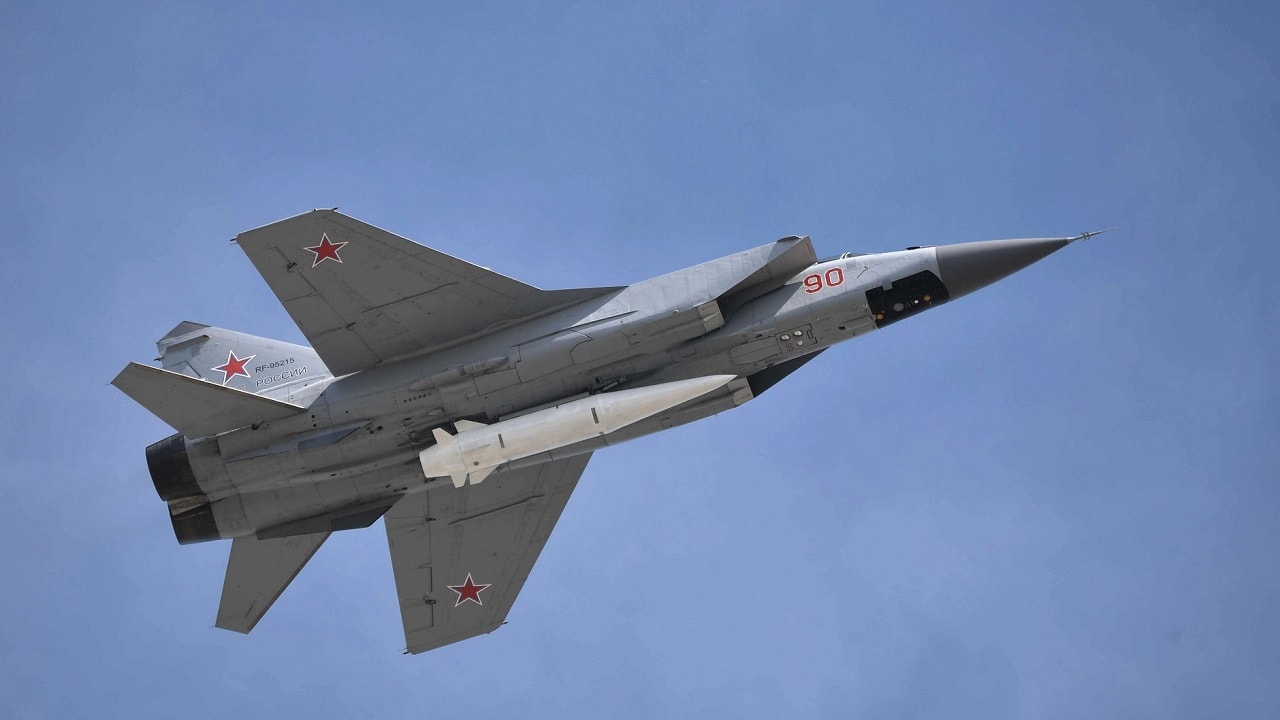
A Kh-47M2 Kinzhal ALBM being carried by a Mikoyan MiG-31K interceptor.
This repurposing is a cost-effective method for Russia to field a new strategic capability, leveraging the unparalleled performance of a proven, if aging, airframe without the expense of developing a new bomber. This new role as a tool of strategic asymmetry allows Russia to hold high-value targets at risk from unpredictable attack vectors, stressing and complicating the calculus for even the most advanced Western air defense systems.
The Modernized Foxhound: A Lineage of Upgrades
The MiG-31’s longevity is a direct result of continuous, albeit sometimes reactive, modernization programs designed to keep the aging but capable platform relevant against evolving threats.
Early Evolution: MiG-31DZ and MiG-31B/BS
The first significant production enhancement was the MiG-31DZ, which introduced a semi-retractable in-flight refueling probe on the port side of the fuselage, dramatically increasing the aircraft’s patrol time and operational range.
A more critical upgrade followed in 1990 with the MiG-31B. This new variant was a direct response to a major security breach: the compromise of the original Zaslon radar’s secrets to the West by Phazotron engineer Adolf Tolkachev.
This reactive modernization was essential to restore the system’s integrity. The MiG-31B featured a new, more secure version of the radar, improved electronic countermeasures (ECM) and electronic warfare (EW) suites, and compatibility with the upgraded R-33S missile.
Concurrently, baseline MiG-31s were upgraded to a similar standard and designated MiG-31BS; the primary difference was that most BS models lacked the refueling probe.
The “Deep Modernization”: MiG-31BM and BSM
By the 2000s, the threat environment had shifted again, with advanced Western fighters, new missile technologies, and stealth becoming primary concerns. This prompted a proactive and comprehensive upgrade known as the Bolshaya Modernizatsiya (“Deep Modernization”), resulting in the MiG-31BM, the cornerstone of the modern Foxhound fleet.
This program was a forward-looking enhancement designed to expand the aircraft’s capabilities and ensure its utility for decades.
The MiG-31BM features a completely revamped avionics suite, replacing the 1970s-era analog “steam gauges” with modern liquid-crystal multi-function displays (MFDs) for both crew members, Hands-On-Throttle-And-Stick (HOTAS) controls, and a new, faster Baget-55 series central computer.
The radar is upgraded to the Zaslon-AM standard, which increases the detection range against fighter-sized targets to 320 km and can track up to 24 targets while engaging eight simultaneously—a doubling of its original engagement capability. The upgrade also integrates the potent R-37M missile and adds a true multi-role capability, allowing the Foxhound to employ a range of air-to-ground munitions.
The MiG-31BSM is a parallel upgrade applied to the older BS airframes, bringing them to a standard largely identical to the BM.
The BSM upgrade adds the refueling probe, new heat-resistant canopy glass for safer sustained high-speed flight, and a distinctive rear-view periscope mounted above the pilot’s canopy. Today, the vast majority of Russia’s active Foxhound fleet has been brought up to the advanced BM or BSM standard.
Specialized and Aborted Variants
The history of the MiG-31 also includes ambitious projects that highlight its potential. The MiG-31M “Super Foxhound,” which first flew in 1985, was a radically improved version featuring a more powerful Zaslon-M radar with a larger 1.4-meter antenna, more powerful D-30F6M engines, and carriage for six of the then-new R-37 missiles.
The dissolution of the Soviet Union and subsequent economic collapse prevented it from entering production, but much of its advanced technology was later incorporated into the BM modernization program.
Another specialized variant was the MiG-31D, developed in 1987 as a dedicated anti-satellite (ASAT) weapon carrier. Designed to launch the large 79M6 “Kontakt” missile, its radar was replaced with a specialized upward-looking sensor system. Though only two prototypes were built, this program established the Foxhound’s potential for space-related roles.
|
Feature |
MiG-31 (baseline) |
MiG-31B / BS |
MiG-31BM / BSM |
MiG-31K |
|
|
In-Service Date |
1981 |
1990 |
2008 / 2014 |
2018 |
|
|
Distinguishing Feature |
No refueling probe |
Refueling probe (B), no probe (BS) |
Refueling probe, rear periscope (BSM) |
Centerline pylon for Kinzhal |
|
|
Radar System |
Zaslon-A |
Zaslon-A (upgraded) |
Zaslon-AM |
Modified/removed for strike role |
|
|
Max Detection Range |
~200 km (bomber) |
~200 km (bomber) |
320 km (fighter), 400 km (bomber) |
N/A |
|
|
Track/Engage Channels |
10 / 4 |
10 / 4 |
24 / 8 |
N/A |
|
|
Primary AAM Armament |
4x R-33 |
4x R-33S |
4x R-37M, R-77 |
None (when carrying Kinzhal) |
|
|
Special Armament |
None |
None |
Guided bombs, anti-radiation missiles |
1x Kh-47M2 Kinzhal ALBM |
|
|
Cockpit |
Analog |
Analog |
Digital MFDs |
Digital MFDs |
|
|
Table 1: A summary of key features across major MiG-31 variants, compiled from multiple sources. |
In Service: Doctrine, Confrontation, and Combat
The MiG-31’s operational history spans the height of the Cold War to the front lines of modern conflict, consistently demonstrating the effectiveness of its specialized design.
Guardian of the North: Cold War Operations
Upon entering service with the PVO in 1981, the MiG-31 immediately assumed its intended role as the primary defender of the Soviet Union’s vast and vulnerable northern and far-eastern frontiers.
Deployed in networked groups of four, they created a formidable defensive screen hundreds of kilometers long, capable of engaging any intruder, from high-altitude strategic bombers to low-level cruise missiles.
The Foxhound quickly proved it was the first Soviet interceptor to be a credible threat to the legendary Lockheed SR-71 Blackbird. While the MiG-25 was unable to effectively intercept the high-flying, Mach 3+ reconnaissance plane, MiG-31 crews recorded multiple successful intercepts where they achieved a weapons-quality radar lock.
In a notable encounter on January 31, 1986, a MiG-31 pilot locked onto an SR-71 from 120 km away.
An even more famous incident occurred on October 6, 1986, when six MiG-31s executed a coordinated, multi-axis intercept, effectively bracketing an SR-71 and subjecting it to a simulated all-aspect missile attack.
While no shots were ever fired, these encounters demonstrated a viable tactical solution to the previously untouchable spy plane and reportedly forced a change in SR-71 mission profiles, validating the effectiveness of the MiG-31 system.
A Tale of Two Interceptors: Foxhound vs. Tomcat
On paper, the MiG-31 and the Grumman F-14 Tomcat appear to be direct counterparts: large, two-seat, twin-engine interceptors armed with long-range missiles. In reality, they are products of fundamentally different strategic requirements and design philosophies.
The MiG-31 is a land-based “Area Defense Interceptor” built for the PVO. Its design unapologetically prioritizes raw speed (Mach 2.83) and altitude (over 20 km) to cover vast distances over the Soviet landmass as quickly as possible.
It was never intended for close-in combat, as evidenced by its 5G structural limit.
Its strength lay in the power of its radar and its ability to function as part of a networked defensive barrier.
The F-14 Tomcat, by contrast, was a carrier-based “Fleet Defense Fighter” for the US Navy. Its design was optimized for long loiter times on Combat Air Patrol (CAP) stations, using its powerful AWG-9 radar and up to six AIM-54 Phoenix missiles to protect an aircraft carrier battle group from swarms of Soviet bombers and anti-ship missiles.
Crucially, unlike the MiG-31, the F-14 was also designed from the outset to be a world-class dogfighter. Its variable-sweep wings provided exceptional maneuverability across a wide flight envelope, making it a true air superiority fighter, not just an interceptor.
The Tomcat was a versatile, multi-role naval fighter; the Foxhound was a pure, land-based interceptor.
|
Metric |
MiG-31BM |
F-14D Super Tomcat |
|
|
Primary Mission |
Area Defense Interception |
Fleet Air Defense / Air Superiority |
|
|
Design Philosophy |
Speed/Altitude Dominance |
Versatility / Maneuverability |
|
|
Max Speed (High Alt) |
Mach 2.83 (3,000 km/h) |
Mach 2.34 (2,485 km/h) |
|
|
Max Speed (Low Alt) |
Mach 1.23 (1,500 km/h) |
Mach 1.2 |
|
|
Service Ceiling |
20,600 m (67,600 ft) |
15,200 m (50,000 ft) |
|
|
Combat Radius |
720 km (at Mach 2.35) |
~900 km |
|
|
Thrust/Weight Ratio |
0.85 |
0.92 |
|
|
Maneuverability |
5 G Limit |
7.5+ G Limit |
|
|
Radar System |
PESA (Zaslon-AM) |
Pulse-Doppler (AN/AWG-9) |
|
|
Max AAM Range |
~300-400 km (R-37M) |
~185 km (AIM-54C) |
|
|
AAM Guidance |
ARH (R-37M) |
ARH (AIM-54) |
|
|
Guns |
1x 23mm GSh-6-23 |
1x 20mm M61 Vulcan |
|
|
Table 2: A comparative analysis of the MiG-31 and its closest Western contemporary, the F-14 Tomcat, highlighting their divergent design priorities. |
Trial by Fire: The Russo-Ukrainian War
The 2022 full-scale invasion of Ukraine has provided the first major combat test for the MiG-31, where it has emerged as one of Russia’s most formidable aerial assets.
Operating from a high-altitude, high-speed sanctuary, MiG-31BMs armed with the very-long-range R-37M missile have engaged Ukrainian aircraft with virtual impunity.
The Ukrainian Air Force’s fleet of Su-27s and MiG-29s lack the performance or missile range to effectively challenge the Foxhound in a beyond-visual-range (BVR) engagement, creating a significant asymmetric threat that has resulted in a number of claimed Ukrainian aircraft losses and has forced their pilots to fly dangerously low to avoid detection.
Simultaneously, the MiG-31K variant has had a profound strategic and psychological impact. Every sortie by a Kinzhal-armed Foxhound triggers nationwide air raid alerts across Ukraine, disrupting civilian life and the economy, earning it the moniker of a “terror weapon”.
While Ukrainian forces have demonstrated the ability to intercept the Kinzhal missile using advanced Western air defense systems like the MIM-104 Patriot, each engagement requires the expenditure of extremely valuable and scarce interceptor missiles.
However, the Foxhound fleet is not invulnerable. Its greatest strength—its reliance on a small number of specialized, high-performance airframes—is also its greatest weakness. As the aircraft is no longer in production, every loss is irreplaceable.
Ukraine has logically countered the MiG-31’s aerial dominance by targeting the aircraft on the ground. Successful long-range missile and drone strikes on Russian airbases, such as Belbek in occupied Crimea and Savasleyka deep inside Russia, have resulted in the confirmed destruction of several MiG-31s.
This strategy bypasses the need to challenge the Foxhound in the air and instead attacks its logistical base, turning the conflict into a battle of attrition between Ukrainian precision-strike capabilities and Russian airbase defenses.
Sunset or New Dawn? The Future of the Fleet
With its airframes aging, the MiG-31 fleet is facing the twilight of its service life, prompting questions about its long-term viability and the ambitious, perhaps unrealistic, program intended to replace it.
The Challenge of Age: Fleet Life Extension
The last MiG-31 rolled off the production line at the Sokol plant in 1994, meaning the youngest airframes are now three decades old.
Russia has embarked on extensive life-extension programs, with the intensive BM/BSM modernizations intended to keep the aircraft in service until at least 2030, and possibly longer.
These overhauls require the aircraft to be completely disassembled to check for structural fatigue before being rebuilt with modern systems.
This effort faces significant logistical hurdles. The powerful D-30F6 engines have a notoriously short time between overhauls, reportedly just 300 flight hours, which places an immense maintenance burden on the force.
While Russia has claimed to have large stockpiles of spare engines, recent official discussions about restarting the production line suggest this inventory may be dwindling.
With a finite number of airframes—perhaps 130-150 operational or in reserve out of ~500 built—the fleet is a dwindling asset. Stored aircraft are often cannibalized for spare parts to keep the active fleet flying, a practice that is unsustainable in the long term.
The Successor: PAK DP / MiG-41
Recognizing the MiG-31’s eventual retirement, Russia has initiated the Perspektivny Aviatsionny Kompleks Dal’nego Perekhvata (PAK DP) program to develop a successor, unofficially designated the MiG-41.
This is envisioned as a sixth-generation stealth interceptor designed to carry the Foxhound’s mission into the mid-21st century.
The claimed capabilities for the MiG-41 are extraordinary, including speeds of Mach 4-4.3, operation in “near space,” the ability to intercept hypersonic weapons, and an anti-satellite role.
However, the PAK DP program is viewed with considerable skepticism by Western analysts. Russia has struggled with the production of its fifth-generation Su-57 fighter and currently lacks a production engine capable of powering a Mach 4+ aircraft.
Given these industrial and technological challenges, many view the MiG-41 as more of a long-term aspiration or propaganda project than a viable program with a realistic timeline to replace the MiG-31 in the 2030s.
This creates a potential “capability chasm” for Russian air defense. As the MiG-31 fleet inevitably reaches the end of its structural life, it is highly unlikely that the MiG-41 will be ready to replace it in sufficient numbers.
No other aircraft in the Russian inventory, including the Su-57, can replicate the Foxhound’s unique combination of speed, range, and altitude.21 This suggests Russia will face a period where its ability to conduct its long-held doctrine of wide-area air defense over its northern territories will be significantly degraded.
Conclusion and Expert Assessment
The Mikoyan MiG-31 “Foxhound” is an aviation paradox: a relic of a specific Cold War doctrine that has proven uniquely and brutally effective in a 21st-century conflict.
It is the ultimate realization of the pure interceptor, a design that sacrificed maneuverability and versatility for unparalleled dominance in speed, altitude, and sensor reach. Its introduction of the Zaslon PESA radar and its networked operational concept were genuinely revolutionary, presaging the network-centric warfare of the future.
Its core performance attributes remain formidable. The ability to sustain supersonic cruise at Mach 2.35 and dash to Mach 2.83 at altitudes exceeding 67,000 feet, combined with the extreme range of its modernized Zaslon-AM radar and R-37M missiles, creates a sphere of influence that few modern aircraft can challenge directly.
However, its lack of agility makes it highly vulnerable in any close-range engagement, and its high operational cost and the immense maintenance burden of its aging, out-of-production airframes make it a fragile, finite, and ultimately irreplaceable asset.
The MiG-31’s continued relevance highlights a crucial lesson in military aviation: while the dominant trend is towards flexible multi-role platforms, overwhelming performance in a specific niche can still create decisive tactical and strategic advantages. Yet, the Foxhound’s story is also a cautionary tale about the long-term risks of over-specialization. The Soviet decision to invest in this highly specialized platform paid dividends for decades, but now presents Russia with a critical single point of failure.
As the fleet ages towards an inevitable retirement, Russia faces the monumental challenge of replacing a unique capability that is central to its defense doctrine—a task for which there is no easy or guaranteed solution on the horizon.
The future of the dedicated heavy interceptor concept itself hangs in the balance, likely to fade with the last of the Foxhounds.
About the Author: Harry J. Kazianis
Harry J. Kazianis (@Grecianformula) is a national security expert based in Orlando, Florida. Kazianis was Senior Director of National Security Affairs at the Center for the National Interest (CFTNI), a foreign policy think tank founded by Richard Nixon based in Washington, DC. He also served as Executive Editor of its publishing arm, The National Interest. Harry has over a decade of experience in think tanks and national security publishing. His ideas have been published in the NY Times, Washington Post, Wall Street Journal, CNN, and many other outlets worldwide. He has held positions at CSIS, the Heritage Foundation, the University of Nottingham, and several other institutions related to national security research and studies.



